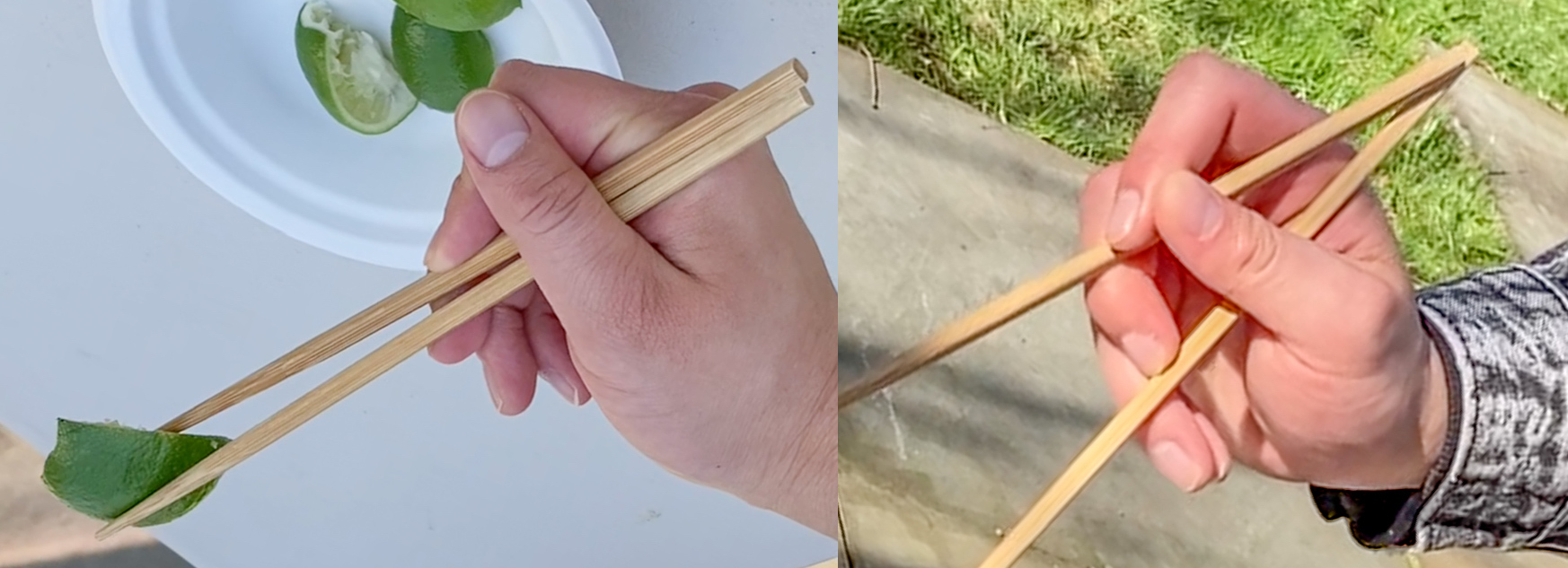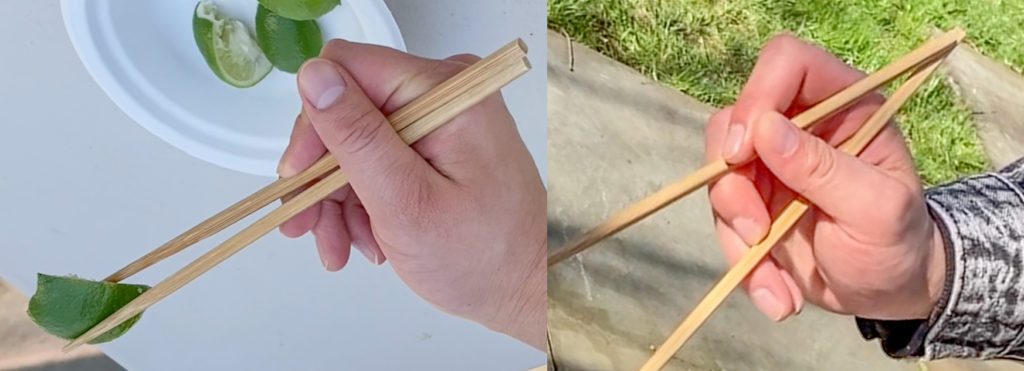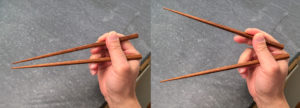Last Updated on June 14, 2021 by Staff
Lateral Turncoat is a special variant of Lateral Classic. With this grip, the tip segment of the thumb does not remain completely unused, as is the case with the rest of chopstick grips from the large Lateral family. Its Compression posture looks like any other thumbless Lateral grip. But its Max open posture is indistinguishable from that of the thumb-using Turncoat grip. This grip can be said to be a true hybrid of Lateral Classic and Turncoat. Thus the name.
Table of Contents
Compared to Lateral Classic
Following pictures compare Lateral Turncoat to a Lateral Classic grip. Images on the left show the Compression posture. Images on the right show the Max open posture. It is immediately clear that Lateral Turncoat and Lateral Classic share the same compression biomechanics. They both clutch two chopsticks closed in the same way. But their Max open postures are completely different. The key difference to note is where the tip segment of the thumb is, and whether it is helping to move the top chopstick. In Lateral Turncoat, the thumb tip prods the top chopstick away from the bottom chopstick. In Lateral Classic, the thumb tip does not engage any chopsticks at all.

Compared to Turncoat
Now we compare Lateral Turncoat to the thumb-using Turncoat grip. Images on the left show the Compression posture. Images on the right show the Open posture. The two images on the right look very similar. In both Open posture images, the tip segment of the thumb operates the top chopstick, in concert with the index finger. And the middle finger idly rests on the bottom chopstick. This is the signature pose of the Turncoat grip. But the Compression postures on the left tell a different story. As the article on Lateral Classic describes, all Lateral grips form a triangle at the Compression posture, with the rear ends of chopsticks abutting each other. And the tip of the thumb is out of a job at this posture. The plain Turncoat grip, on the other hand, and like most thumb-using grips, form a triangle with the rear ends far separated, for a better grasping experience. In plain Turncoat, the tip of the thumb continues to operate the top chopstick during compression.
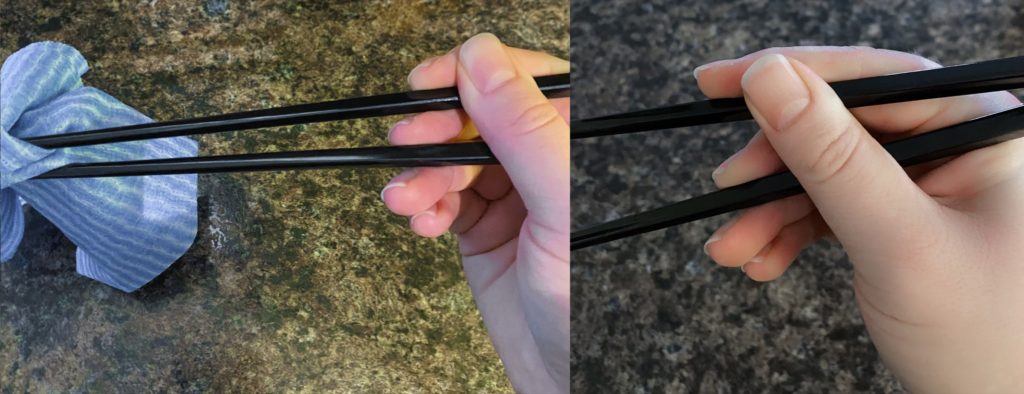
Transitions between Closed and Open postures
These two video clips demonstrate how a practitioner manipulates chopsticks between the Closed posture and the Open posture. We call this reciprocal move the alternating motion of chopsticking. Follow the tip of the thumb throughout the move, to see when it participates, and when it disengages. Then follow the middle finger, and study when it actively braces against the bottom chopstick to provide leverage, and when it fades into the background.
When not picking up food items, practitioners do not need to worry about applying compression forces. Thus we also refer to these Open and Close posture as “relaxed” postures. Practitioners only need to apply light forces, enough such that the two chopsticks don’t drop off, while they are juggled by fingers. When moving chopsticks between these two relaxed poses, the thumb never does need to assume the position it would be in, when applying significant compression. This is especially evident in the movement of User49, shown above right. Her thumb tip never did leave the top chopstick, unlike user36 shown above left. User49’s middle finger also lingers on the bottom chopstick. The end result is that the Closed-Open move of Lateral Turncoat could look similar to the plain Turncoat grip, when operating “relaxed” postures.
Transitions between Compression and Open postures
When actual compression forces are called for, however, the thumb can be seen to alternate between two very different roles. Again, follow the tip of the thumb in these moves. It is seen assuming its position forward, away from rear ends of chopsticks, when helping to extend chopstick tips apart. It is seen retreating towards the rear, and absconding any roles, when the base of the thumb clutches the two chopsticks closed. At the same time, the middle finger can be seen bracing against the bottom chopstick when helping to extend chopsticks apart. It completely fades into the background, and allows the bottom chopstick to rest on it, when the hand clutches sticks closed.
Key moments in Lateral Turncoat
Key postures of this grip are shown below. From left to right, they are: 1) Abutting posture, 2) Compression posture, 3) Closed posture, 4) Open posture, and 5) Max open posture. Once more, they show the tip of the thumb undergoing changes in role, from left to the right, as the hand extends chopsticks apart. On the far left, only the base of the thumb touches any chopsticks. On the far right, the tip of the thumb is actively operating the top chopstick.

Following are similar key postures featuring the other practitioner.
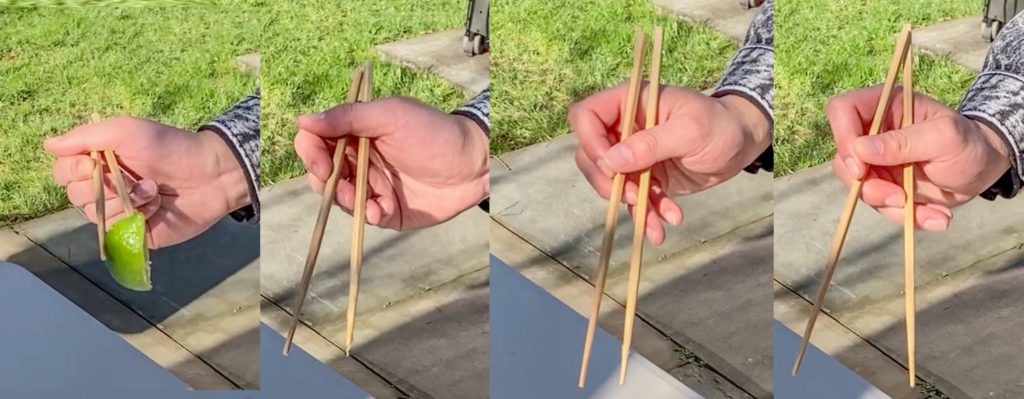
Related grip: Lateral Gangnam Style
Below is yet another practitioner wielding the a grip similar to Lateral Turncoat. In this case, flat Korean chopsticks are used. These are much harder to use compared to square chopsticks, as they are virtually impossible to roll. See the article on planetary gears about why rolling of chopsticks are important to chopsticking. It is just different and special enough, that we gave this variant it own name: Lateral Gangnam Style.

Taiwanese: 邊仔中指投誠
This grip is known as 邊仔中指投誠 (piⁿ-á tiong-cháiⁿ tâu-sêng) in Taiwanese.
